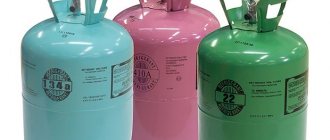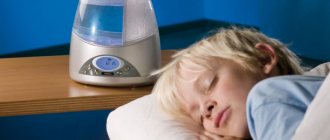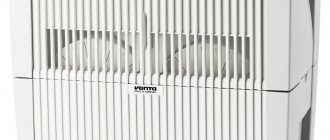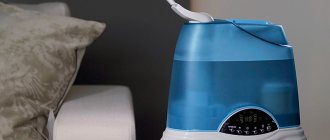- Factors influencing climate in production and industry
- Where are industrial humidifiers needed?
- Humidity value
- Operating principles
- Types of industrial humidifiers
- Types of Humidifiers
- Ultrasonic humidifiers
- Automatic humidification system for air fogging in industrial premises
- Block diagram of an automatic high-pressure air humidification/fogging system
Send a quick request Air humidification is an important component of an optimal microclimate not only for humans.
Many technological and manufacturing processes also require maintaining optimal humidity levels to ensure the production of quality products. Air humidification in production areas is becoming increasingly important in many industries. Modern requirements for temperature and humidity conditions lead to the need to use air humidification systems in technological processes.
INTECH-Climate is ready to implement professional solutions for climate control and other engineering equipment. We will carry out a full cycle of turnkey work: design, selection, delivery, installation and maintenance. Call now: +7 (495) 146-65-64
. Submit your application
Factors influencing climate in production and industry:
- during the heating season, the level of air humidification at the enterprise is reduced to 12%-14%, with the norm being 45%-60%;
- when modernizing equipment, air exchange increases, which leads to a decrease in normal air humidity;
- Low air humidity increases the production of defects, leads to damage to raw materials and finished products, which sharply increases the cost of production.
Undoubtedly, creating a favorable climate in industry not only makes it possible to meet the high modern requirements for production premises.
In many industries, maintaining a certain level of humidity becomes one of the factors of production:
- air humidification in printing houses is becoming increasingly important during the printing process;
- in the woodworking and furniture industries, the moisture content in wood is directly related to the temperature and level of humidity in the room;
- in the textile industry, the level of fabric moisture is directly related to increasing the tensile strength of natural fibers and reducing the number of defects;
- Air humidification in agriculture and the tobacco industry also plays an important role.
And most importantly, additional air humidification in the company has a beneficial effect on the well-being of staff.
Where are industrial humidifiers used?
- In the printing industry.
- In the field of food and food storage.
- In the textile industry.
- In the chemical and pharmaceutical industries.
- In the woodworking and construction industries.
In printing houses, the climate requirements are strict: the temperature should be about 21 ° C, relative humidity - 55%. Paper is susceptible to moisture and hygroscopic, so it reacts significantly to changes in humidity levels. For example, in winter, if you do not additionally humidify the air, it can become deformed, dry out and accumulate static electricity, due to which the sheets stick together and failures occur during the printing process.
Ultra-low oxygen chambers are often used in the food industry. They allow you to keep food fresh, but there is also a negative side effect: during long-term storage in such a chamber, too much moisture is removed from the products, they lose weight and presentation. To compensate for this, air humidification systems are used.
Lack of moisture harms not only people, but also tissues - they become less durable. In addition, dust forms much more actively in dry air - it pollutes products and machines, and harms the production process itself.
Climatic conditions are critical for the production of fertilizers and medicines and laboratory research.
It is necessary to maintain the required level of humidity to avoid drying out of the material and the appearance of defects.
Additional air humidification is also needed for museums, libraries, archives and storage facilities, server stations and any areas of production where manual labor is involved in large quantities.
Where are industrial humidifiers needed?
The presence of special climatic conditions is necessary in various production areas - problems with dry air are common in many production workshops and warehouses. The rooms that most need humidification of air masses are:
- Base and server stations. Since dry air allows the accumulation of excessive charges of static electricity, this contributes to the creation of threats to the normal work process.
- Museums and libraries. The presence of a stable microclimate will ensure the safety of exhibits and printed publications.
- Printing houses. During the production of printed products, air humidity must be maintained at an optimal level so as not to lead to a decrease in the quality characteristics of the paper.
- Textile industry. Since low air humidity affects the strength characteristics of fabrics, equipping workshops with humidifiers is simply necessary.
- Woodworking industry. Wood, in order to preserve all its qualities, simply needs to be in an optimal humidity environment so that cracks, splits and deformations do not occur.
- Medical and pharmaceutical purposes. An optimal level of humidity should be maintained both in places of production of medical drugs and in places of their storage, and even in places of direct use - in medical institutions.
The variety of applications leads to the availability of many types of industrial air humidifiers.
Areas of application of the devices
Powerful devices were specially created for industrial premises. They solve the problem of dryness, which can negatively affect the quality of the products produced.
Before arranging the space, it is recommended to study in detail the types and technical characteristics of individual systems:
- The basic and server version is installed to combat static electricity. Climate control equipment must create optimal conditions that minimize the likelihood of industrial accidents. The threat can not only stop the process, but also negatively affect human health.
- Museums and libraries contain valuable exhibits that can deteriorate if the air is too dry. Books and art objects must be kept in special conditions. They can be provided with the help of special devices. Improper storage will lead to fatal consequences.
- also necessary for printing. Otherwise, the paper may quickly deteriorate. Excessive dryness also leads to difficulties in the printing process. Climate control equipment is necessary to ensure good quality of products. Otherwise, the paper begins to dry out and becomes more brittle. The structure suffers even from slight mechanical stress.
- Industrial air humidifiers are also installed in all textile enterprises. Thanks to them, it is possible to significantly reduce the percentage of defective products. Additionally, it is possible to speed up the production process. Employees feel comfortable, so their productivity increases several times.
- The devices are installed in most warehouses where finished products have to be stored for a long period of time. A humidifier allows you to preserve quality and reduce the impact of all harmful factors. Due to drying out, cracks and deformations most often form on the packages. If the process is not stopped in time, their contents will also deteriorate.
Industrial systems are selected after a detailed analysis of technical characteristics:
- The low pressure system allows for quick start-up. The device contains only compressed air. It is characterized by good performance and small size and weight. This option is recommended to be located in warehouses where highly hygroscopic materials are stored.
- It is advisable to use industrial high-pressure air humidifiers in large rooms. The design is designed for high labor productivity with minimal energy consumption.
- If it is necessary to normalize the climate in a residential area, it is recommended to use a drum-type system. Their work will only be effective in small rooms. A combination of devices with a forced ventilation system is allowed. Among the advantages, it should be noted that it is quiet and easy to control.
Humidity value
Air humidity plays an important role in the functioning of the human body. Using climatic devices it is possible to significantly extend the shelf life of vegetables, fruits and other goods. The general atmosphere in the room also affects the quality of the product. Manufacturers must carefully consider the appropriateness of the devices and the functions of the devices they purchase. An industrial steam humidifier has a positive effect on people's well-being. Labor productivity increases and the risk of fatigue decreases. Otherwise, depression may occur and the person may become ill.
Air humidification systems in industrial premises should be used in conjunction with the following units:
- Heating and other types of heating devices.
- Air conditioning in the hot season.
- The room requires long-term air exchange in dry weather.
- An industrial steam humidifier is necessary in certain industries and areas of human activity. The condition is considered mandatory. In the absence of a device, the risk of property damage increases or the quality of the finished product deteriorates.
Industrial air and its components are monitored using special instruments. Thanks to them, it is possible to achieve optimal condition in any room.
An industrial humidifier can have different capacities. The indicator is calculated depending on the area of the room. Its purpose and other parameters are also taken into account.
How to choose an air humidification system for industrial premises
To choose a humidification system that will sufficiently supply the air with moisture and that you can easily and inexpensively maintain, you should focus on several factors:
- Type of production premises and its specifics. For example, ultrasonic humidifiers are not suitable for museums, libraries, archives and printing houses due to the inevitable white coating, which can quickly bring old documents, books, paintings or antiques into poor condition.
- The required performance of the device, which is determined depending on the area of the room, ceiling height, number of employees and equipment in it.
- Accuracy of work. Most humidifiers are not capable of maintaining humidity levels to the nearest percentage.
- Control method. An automatic system is always more convenient than a manual one, since it does not require constant monitoring.
Price and ease of maintenance also matter. Based on all of the above parameters, nozzle systems are the best option for industrial humidification.
How does a nozzle humidification system work?
Spray humidification systems are of the adiabatic type. Their operating principle is to spray distilled and disinfected water under high pressure through small nozzle holes. Water is crushed into droplets 10 - 30 microns in size, which evaporate in a fraction of a second. The air is quickly saturated with moisture, and furniture, equipment or other items in the room are not damaged.
In a professional nozzle system, everything must be thought out to the smallest detail. To achieve better results, filters purify water to a distillate state. The spray nozzles are made of stainless steel and equipped with artificial ruby or sapphire inserts, which provide them with additional strength and prevent deformation. The performance of one nozzle can vary from 1 to 3.5 liters of water per hour, depending on your needs. Immediately before spraying, the water passes through a vortex chamber to prevent the formation of too large droplets.
The big advantage of the spray humidification system is its quiet operation at any capacity.
Advantages of adiabatic nozzle humidification systems
- Adiabatic humidification systems are fully automated. After installation, the equipment is configured once and then controls the desired humidity level in the production area. Water for humidification comes into the system from the water supply, so there is no need for manually filled containers or reservoirs. Once in the system, water undergoes multi-stage filtration and is sterilized by ultraviolet light, and only then is supplied to the spray nozzles. Such deep cleaning ensures absolute microbiological safety and hygiene. This is especially true for food industry enterprises and various laboratories.
- The direct spray humidification system is suitable for rooms of any size. The equipment humidifies the air as naturally and effectively as possible, maintaining humidity at an optimal level, while consuming very little energy. Depending on the size of the room to be humidified, the performance of various models ranges from 6 to 30 W per liter of water per hour. An important advantage of the spray system is multizonality. Thanks to this function, you can set the desired humidity for each office or workshop.
- Thus, there is no need to add water, there is no risk of microbiological contamination, and thanks to the highest level of water purification, there is no white residue on the equipment.
And by the way, your employees will thank you for the feeling of freshness that reigns in rooms with spray humidification.
Operating principles
An industrial humidifier is a device whose main purpose is to provide proper humidification of air masses on a large scale. Despite the variety of devices for air humidification in production, they all work based on one of two principles:
- Adiabatic.
- Isothermal.
The action of humidifiers that have an adiabatic operating principle is based on the natural process of evaporation. The air flow absorbs moisture, subsequently converting it into steam. Since this process requires considerable energy consumption, it is accompanied by a decrease in the air temperature in the room.
The action of isothermal humidifiers is based on mixing air with the generated steam. This type of industrial humidifiers does not change the air temperature in the room during operation.
Classification of systems by pressure level
Typically, industrial-type humidifiers are divided into low- and high-pressure models. The first category is characterized by quick installation and the ability to start a humidification system by connecting a compressor that directs compressed air. These are compact units that provide an average output of 50 l/h. Such equipment in standard modifications is used in small warehouses where it is necessary to maintain optimal humidity levels for storing hygroscopic materials - for example, veneer, paper, etc. For more serious tasks, a high-pressure humidifier is designed. Industrial units of this type provide productivity up to 2,500 l/h. Equipment with such capabilities requires more energy consumption, but is capable of guaranteeing normalization of the air environment in difficult conditions at construction plants, large greenhouses, printing houses, etc.
We recommend reading: Wall insulation with penoplex - technology for thermal insulation of facades with siding, how to choose the thickness of brick and aerated concrete houses
Types of industrial humidifiers
The most commonly used industrial humidifiers are the following types:
- Sprayers.
- Working on ultrasound.
- Sinks.
Sprayers (also called atomizers) work on the principle of aerosols, spraying drops of moisture at certain time intervals. Devices of this type are equipped with a certain number of sensors, depending on the manufacturer and model. Sensors allow you to regulate the operation of the humidifier based on the specified temperature and humidity parameters of the air.
Industrial humidifier performance calculation
The main parameters for choosing an industrial humidifier are its performance and restrictions on electricity consumption at the site. Factors that influence the choice of the type of device are the purity of the water and the balance of temperature inside the room.
The following main parameters are taken into account when calculating:
- Outdoor temperature and humidity;
- Required indoor temperature and humidity;
- Ventilation unit capacity (m3/hour);
- Room volume (m3);
- The time it takes for an industrial humidifier to reach a stable operating mode;
- Other factors that affect the required productivity: the number of pieces of equipment, the number of people in the office or workshop, the hygroscopicity of materials or structural elements of the floor, walls, ceiling, etc. go to section
Types of Humidifiers
The operation of all humidifiers is based on one of the methods of processing moisture into gas (isothermal or adiabatic); there are different types of humidifiers. Let's look at how different they are and what their positive and negative aspects are.
Types of humidifiers:
- Heating humidifier. It consists of several elements: a tank for heating water, a heating element, a hose that discharges steam into the air duct, a tube with holes that evenly distributes steam into the air. The resulting steam will be superheated to avoid condensation forming inside the device.
- Infrared humidifier. It is designed in the same way as the previous humidifier, only the heating element here is infrared lamps.
- Electrode humidifier. It produces steam due to the phenomenon of water dissociation, i.e. Voltage is applied to the electrodes (anode and cathode) lowered into the water, an electric current is released, the water heats up and begins to be converted into steam.
- Evaporative humidifier. Evaporation of moisture in it is achieved by blowing air onto water, which, in turn, is applied to the surface intended for this purpose (most often the surface is made of plastic or paper).
- Disintegrating humidifier. Splits water into many small particles under pressure (using a water pump or using compressed air). After this, the resulting fine particles are sprayed into the air stream and evaporate.
- Ultrasonic humidifier. The latest development works as a membrane that vibrates intensely, onto which water falls and is very quickly sprayed into a whole cloud of microparticles. The air that passes through this cloud is instantly saturated with moisture.
When using any type of industrial humidifiers, you should ensure that the water that is to be treated is purified. This is necessary to ensure that the air does not become polluted.
General information
Ultrasonic industrial-type air humidifiers, which are used for industrial purposes, operate using two technologies. Isothermal models mix air flow with released water vapor - steam humidifiers. In other words, the equipment turns water into steam. The second common technology is wetting the surface with water. Adiabatic humidification is based on the natural evaporation of water into the environment. Due to the fact that the surrounding air and steam above the water have different partial pressures, molecules with the greatest kinetic energy are released.
Although there are only two methods of converting moisture into steam, there are 6 types: heating, infrared, electrode, evaporative, splitting and ultrasonic humidifier. The last type is an innovation. Our industrial ultrasonic humidifiers work thanks to a vibrating membrane. Due to intense vibration with a frequency of 20 kHz, it is capable of very quickly spraying droplets (cavitation effect), forming a cloud. The air that passes through it is saturated with moisture. Thus, using cavitation, they create a fine water mist with a droplet diameter of 1-5 microns, which spreads throughout the room.
An industrial ultrasonic humidifier is the optimal choice for highly efficient and easily controlled saturation of the interior space with moisture. The main thing to remember when using it is that only purified water should be poured into an industrial ultrasonic humidifier. This will avoid contamination of its internal parts, deposition of calcium, fluorine, chlorine salts, and also prevent the appearance of pathogenic microorganisms in the air. A coarse filter and connection kit are included.
Ultrasonic humidifiers
These are the most popular and in demand humidifiers today, let's figure out why?
As we said, with the help of ultrasound, something like fog is created, which spreads throughout the room, after which, in a natural way, this fog turns into steam, and this leads to an increase in air humidity.
To ensure that harmful impurities located in the separated water cloud (various salts, microorganisms, etc.) do not remain on furniture, clothing and technical devices, ultrasonic humidifiers are equipped with special filters. Typically, they are made in the form of cartridges that can be replaced when necessary.
In addition, ultrasonic humidifiers are capable of precise control over the humidity level of the entire room. Using an ultrasonic humidifier, you can achieve almost 100% air humidity. They are economical because they have an automatic control program and a capacity of more than 10 liters per day. Only an ultrasonic humidifier can produce warm steam at a low noise level.
But, like any device, industrial air humidifiers have their own characteristics and disadvantages. The disadvantages include the fact that the capacity of an ultrasonic humidifier is limited in size, which is why it needs to be constantly replenished with water. Also, if you do not replace the filter cartridge after 4 months of its operation, salt deposits will appear on various household items surrounding the device.
When choosing ultrasonic humidifiers, remember that their use is absolutely harmless to human health, because the ultrasound in them only causes the membrane to move. No other method except ultrasonic can achieve such frequent vibrations.
When thinking about purchasing an air humidifier, be it industrial or household, ultrasonic or electrode, remember that you cannot skimp on your own health and the health of others. You should choose the most suitable option, the most harmless and effective.
Reasons for decreased humidity
The level of relative humidity inside a serviced room affects people’s well-being no less than their diet, work and rest schedule, or fresh air saturated with oxygen. If there is no industrial humidifier in the building, then a person may experience various ailments and even health problems due to low moisture content.
There are several common reasons why humidity may be reduced:
- In winter, it decreases due to the inclusion of the heating system, which warms up the internal air and at the same time dries it (in the absence of humidification, it decreases by up to 10%).
- In summer, the air flow entering rooms from the street has a high temperature plus a low moisture content. In addition, when using air conditioners, it also dries out additionally.
- Production workshops are large. Because of this, air distribution in them is poor. Here it is necessary to install an industrial humidifier directly in the workshop.
- Significant moisture losses occur due to certain technological processes.
- The main raw materials obtained, as well as operating production equipment, take moisture from the workshop, reducing its overall level.
In apartments of multi-storey buildings there are big problems with controlling humidity in the rooms, let alone industrial buildings or structures. Therefore, it is simply necessary to install a humidifier there.
Automatic humidification system for air fogging in industrial premises
Designed to automatically maintain a given air humidity in industrial premises.
The principle of operation of the system is to increase the water pressure of the system to a certain value using a high-pressure piston pump. Water under a pressure of 70-200 atm through a high-pressure pipeline is sprayed with special nozzles (nozzles) with particles up to 5 microns in size, i.e. When sprayed, the water turns into a state of saturated steam - fog. Water particles (fog) when sprayed absorb heat from the air and thereby humidify the air and reduce its temperature
The water spray nozzle is made using titanium alloy materials and has a pressure limiting valve. The body is made of copper materials or stainless steel. The nozzles have the following characteristics: atomizing water to sizes of 5...15 microns, no wear, small pressure losses, no water leakage, etc.
The main part of the automatic air humidification installation consists of a high-pressure piston pump, which can operate continuously for 24 hours. The injectors and pump do not have mechanical parts that are easily damaged, and therefore are not damaged at high impurity contents. The pump capacity can range from 5 kg/h to 900 kg/h of water and is continuously adjustable. Water for humidification requires special preparation and is in a sealed closed circuit, which avoids the growth of bacteria in this environment.
The automatic air humidification system consists of a water preparation/filtration station, a water temperature control unit (optional), an incoming water pressure level control, a water supply system under stable pressure, a humidity control unit with an LCD monitor, etc.
Water from an external pipeline is supplied through a filter to the tank, which has a water level control system, a water heating and temperature control system. Next, the purified water enters the high-pressure pump, high-pressure pipeline and nozzles (nozzles), where it is then sprayed in the form of fog. The high pressure pump drives an individual electric motor. An LCD unit control device, a humidity sensor and a high-pressure electromagnetic pump make up the humidity control system.
The number of nozzles of one module of JY high pressure automatic humidifier can be from 40 to 300, the amount of evaporated water is 140~1050 kg/h. The volume of the room for humidification is 1500~60000 m³.
The design of the nozzles (made in Taiwan) uses the principle of protection against backspray; they are manufactured using precision technology and have a long service life.
Depending on the required humidity parameters, you can automatically control humidification in different zones of the room through one or several channels, thereby ensuring individual humidity in a specific zone.
Rating of high-quality electrode humidifiers
Ballu Machine BMH-090
An excellent electrode option that will provide the room with a high-quality microclimate for a long period. The case is made of stainless steel, which will not lose its strength properties. The productivity of the device is 180 kg per hour. The cylinders are dismountable, which makes it possible to carry out maintenance and increase the durability of the equipment. The controls are simple and there is an LCD display for convenience.
The average price is 430,000 rubles.
Ballu Machine BMH-090
Advantages:
- Italian brand;
- Performance;
- Durability;
- Assembly;
- Easy to clean;
- Durable housing.
Flaws:
- High price.
Carel CH001V2001
A high-quality model with submersible electrodes, which is suitable for frequent use. The body is made of durable materials that have a long service life. The peculiarity of the device is that it has automatic control of the concentration of water salts, which makes operation more efficient. There is also a resettable cylinder operating time counter. Maximum pressure – 1000 Pa.
Sold at a price of 60,000 rubles.
Carel CH001V2001
Advantages:
- Low price;
- Durable housing;
- Reliability;
- Long service life;
- Light weight.
Flaws:
- Only for small spaces.
humiSteam UE001XD0E1
An excellent humidifier with a non-removable cylinder that can be installed in any enterprise. High-quality assembly guarantees a long service life with a minimum number of failures. The case is made in the usual form and has small dimensions, which makes it possible to place the device anywhere. There is self-diagnosis, anti-foaming protection, adjustment of problematic water, etc.
The average price is 190,000 rubles.
humiSteam UE001XD0E1
Advantages:
- Small size – 365x275x712 mm;
- Price;
- Performance;
- Reliable assembly;
- High-quality element base.
Flaws:
- Not detected.
Why do you need an industrial humidifier?
Industrial humidifiers differ from household ones in power and control methods. Necessary for long-term human performance indoors, as they create the necessary air parameters. One of these parameters is relative air humidity. In addition, the air must contain 40-60% water vapor from 100% moisture saturation; these parameters should also be taken into account when creating an artificial microclimate. Also, many industries require an increased level of air humidity, higher than the usual comfortable level for humans.
Humidifier selection
When choosing an industrial ultrasonic humidifier, you need to remember that they are harmless to the human body. For industrial models, it is important to have a durable case that can withstand harsh operating conditions. A large digital display is another important feature of such equipment. In this case, it will be convenient to track indicators even in poor lighting.
The presence of wheels will make it easy to move the industrial ultrasonic humidifier around the workshop, especially considering the large size of industrial areas. The floor in production is not always level, so the presence of a brake will be an additional advantage. Considering regular use, the device should consume electricity economically. A good choice would be models that require only 300 W for 60 minutes of operation.
Choose an industrial ultrasonic humidifier with a system for uniform supply of water vapor so that the entire room has the same humidity. This parameter is especially important for warehouses. Otherwise, the goods will deteriorate faster in remote corners.
If there is little free space in the room, then you need a compact device. For example, the Danvex humidifier can be installed even in cramped conditions. For comparison, the HUM-3S model has dimensions of 600x495x330 mm, and the dimensions of the more powerful HUM-48S are only 860x850x820 mm.











